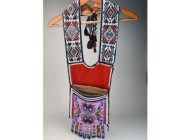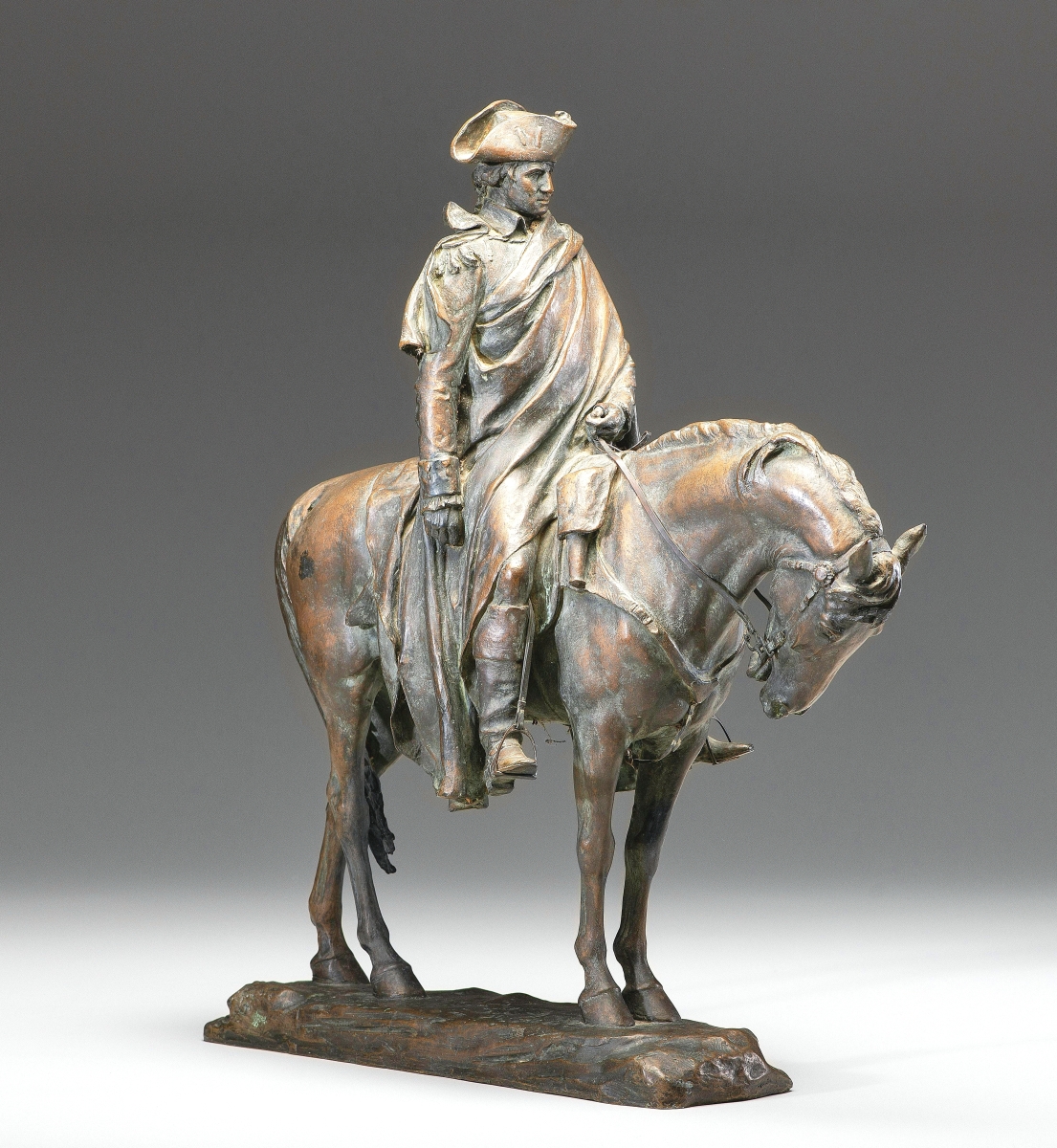
“George Washington at Valley Forge,” by Henry Merwin Shrady (American, 1871-1922) was the artist’s personal model and rode to $71,875 from a private collector ($40/60,000).
Review by Madelia Hickman Ring, Photos Courtesy Hindman
CINCINNATI, OHIO – These days, having even one Andrew Clemens sand bottle in an Americana sale is a good way to spark some bidding fireworks but Hindman doubled down and presented two in its September 14-15 American furniture, folk and decorative arts auction. With 580 lots on offer, the sale realized $2.04 million with a nearly 80 percent sell-through rate. Department director, Ben Fisher, attributed the result to the opening up of shows that provide collectors with purchasing options they did not have during the pandemic when auctions were one of the only venues for acquiring objects.
The sand bottles earned more than half the sale’s total, a combined $1,178,750. Of that, $860,000 – and the second highest price ever realized at auction for a sand bottle by Clemens – was achieved for an 8¾-inch-tall bottle commissioned in 1883-84 by Ezra Williams for the Williams and Upham dredging company. The bottle had descended in Williams’ family and featured a dipper dredge as well as bands of geometric and swirled sand that are considered hallmarks of Clemens’ (American, 1857-1894) work.
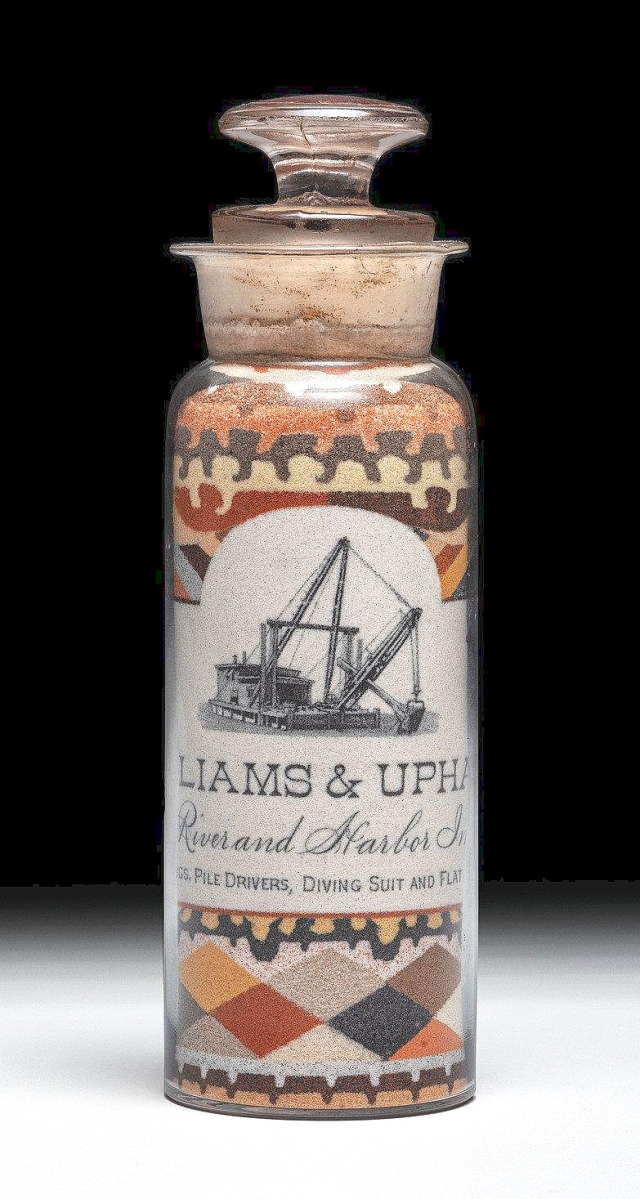
A private collector of sand bottles paid $860,000 for Andrew Clemens’ sand bottle that was commissioned by Ezra Williams for the Williams and Upham dredging company. Not only was it the highest price in the sale but it becomes the second highest price paid at auction for one of Clemens’ bottles ($100/150,000).
What made this particular bottle noteworthy and contributed to its result was a nearly continuous band of text in four fonts, all on a white ground, that read “Williams & Upham / Contractors for River and Harbor Improvements, / Dredges, Tugs, Pile Drivers, Diving Suit and Flat Scows,” as well as “E.T. Williams, L’Anse, Mich.” and “J.H. Upham, Duluth, Minn.” The imagery mirrors that on an advertisement for Williams and Upham that was published in 1884 in R.L. Polk & Co.’s Marine Directory of the Great Lakes; it may have been the design inspiration for Clemens.
The other sand bottle in the auction, which finished at $318,750, was commissioned in the 1880s by Frank Eckert (1866-1923) and depicted a dappled gray Percheron horse named “Louis.” Like the Williams & Upham bottle, it had descended in Eckert’s family. The presentation inscription on the bottle “From Frank B. Eckert” suggests that the bottle was a gift rather than something Eckert ordered for himself, possibly for the family of Rose Birdsey, who would marry Eckert and whose father, Linus, owned a gray stallion named Louis. The family also retained a drawing of the horse that Clemens may have used as the image source.
Both bottles carried estimates of $100/150,000 and both were purchased by separate private collectors of sand bottles.
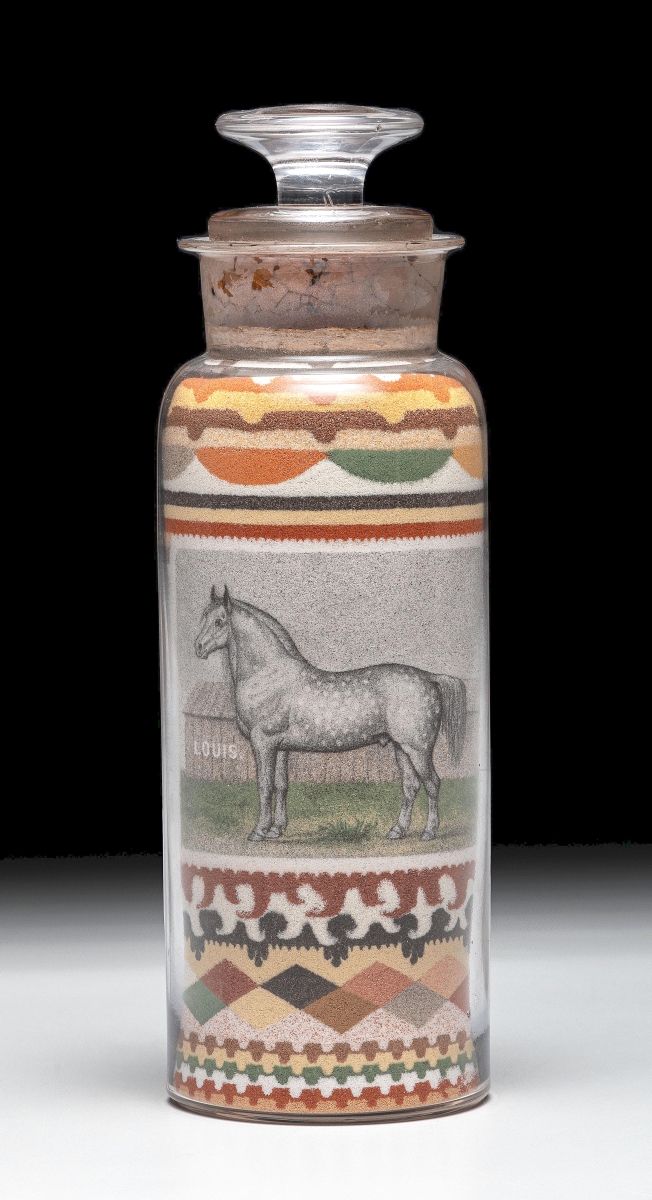
This sand bottle, commissioned from Andrew Clemens by Frank Eckert, depicted “Louis,” a dappled gray Percheron horse. It found a new home with a private sand bottle collector for $318,750 ($100/150,000).
From sand bottles to sculptural works, which also achieved strong results. An iconic image of George Washington at Valley Forge in bronze by Henry Merwin Shrady (American, 1871-1922), that had descended in Shrady’s family to his great-granddaughter, sold to a private collector for $71,875. The Roman Bronze Works cast, marked to the base with a 1904 copyright, stood 25½ inches tall and relates to models in collections at the Metropolitan Museum of Art, the Henry M. Flagler Museum in Palm Beach, Fla., and the Gilcrease Museum in Tulsa, Okla.
For those collectors of Founding Father imagery, a small oil on panel oval portrait of Thomas Jefferson, Nineteenth Century French or American School, fit the bill nicely. A handwritten paper label on the verso reveals that the painting had provenance to the collection of Boston politician and antiquarian, William Henry Whitmore (1836-1900) and Thomas Jefferson Coolidge Jr, the great-great-grandson of President Jefferson. The portrait had been loaned to the Museum of Fine Arts, Boston, by Whitmore in the late Nineteenth Century and, upon his death in 1900, may have been sold at an estate auction where it was acquired by Coolidge. Bidders pushed the portrait from its $3/5,000 estimate to $34,375.
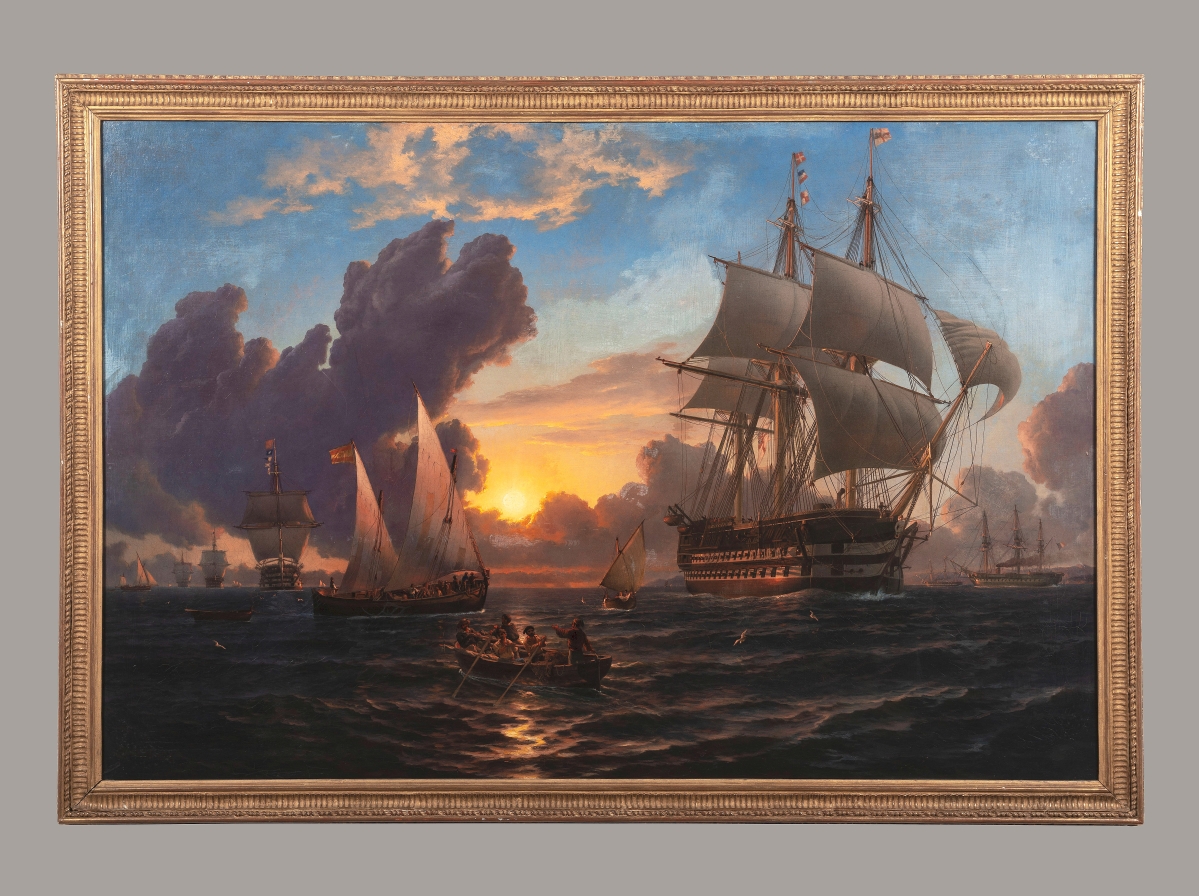
“That is a beautiful painting; the use of light is incredibly impressive,” said Ben Fisher of this circa 1855 oil on canvas painting of the HMS Marlborough at Gibralter that was attributed to Charles Henry Seaforth (English, 1801-1872). It realized $43,750 from an American buyer ($8/12,000).
Two lots of carved nautical gangways, offered consecutively and both from the collection of dealer Norm Flayderman, sailed to impressive results. An eagle, shield and cannon carved and brass-mounted example from the USS Tallapoosa that dated to 1867-77 docked at $50,000, from a private collector. The other lot, a pair of eagle, shield and seal of Cincinnati carved walnut boards that was likely from the USS Cincinnati – and dated to circa 1892 – made $17,500 from another private collector.
Ceramics in the sale included a historically important stoneware cooler made in either North or South Carolina that was marked, in flowing cobalt script, “Colored Republicing Club July 7, 1892.” Standing 12 ¾ inches tall and with a Southern alkaline glaze, Hindman’s catalog states that it was likely made by an African American potter who may have trained in the Edgefield District of South Carolina.
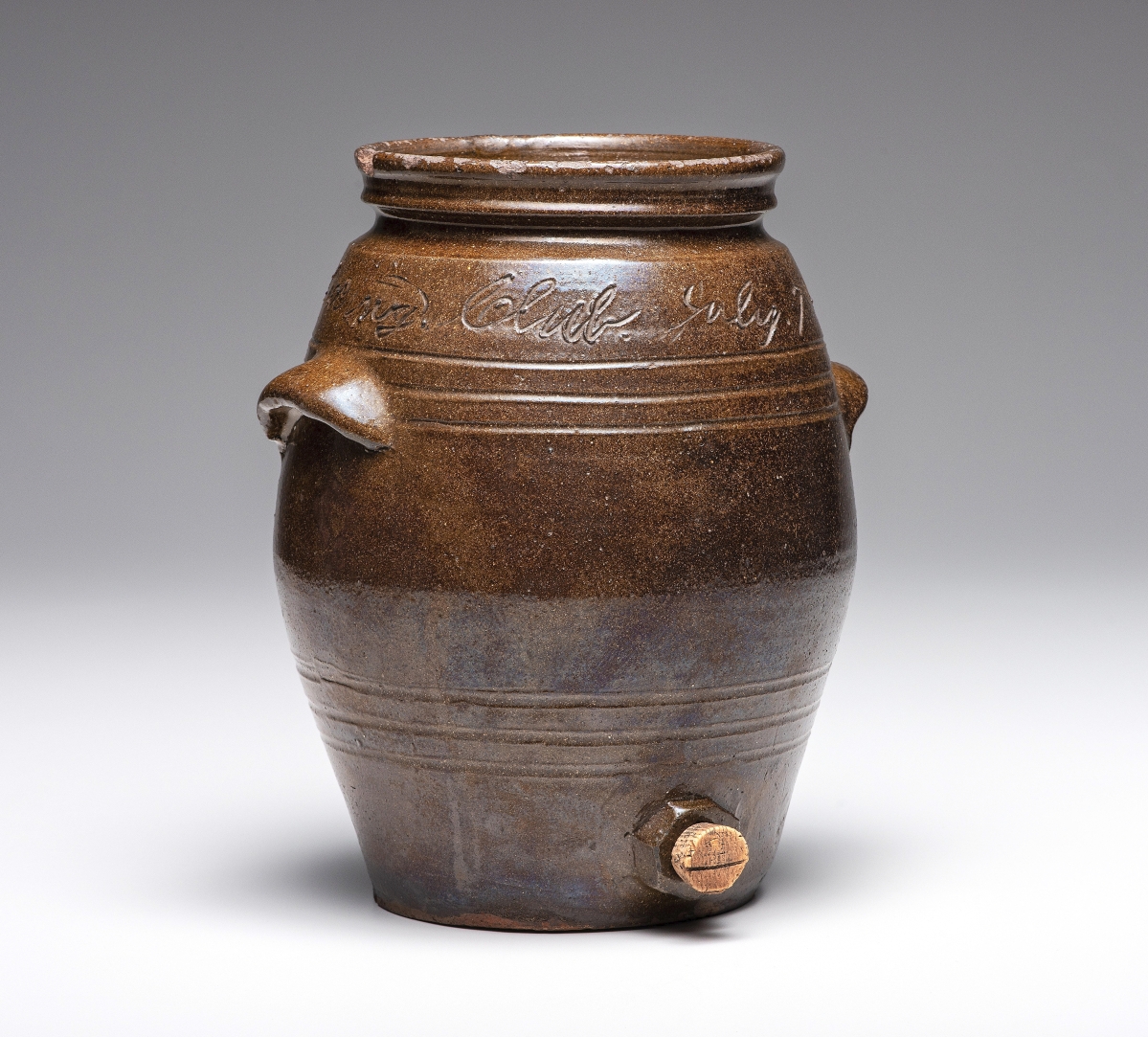
This North or South Carolina “Colored Republicing Club” stoneware cooler was dated July 7, 1892, and is a rare and historically important survivor and represents a dark period in American history when African Americans were becoming disenfranchised from the rights granted to them by the 1870 passing of the Fifteenth Amendment. The cooler was purchased for $43,750 by a private collector and will be subject of an upcoming Ceramics in America article by Wes Cowan and Stephen Compton ($5/7,000).
In both post-Civil War North and South Carolina, “Republican Clubs” were formed but enjoyed short lived influence when white Democrats moved to suppress the Black vote. The cooler is viewed as “symbolic” of a period in Southern politics when African Americans became increasingly disenfranchised from the suffrage granted to them by the Fifteenth Amendment in 1870.
The cooler sold to a private collector for $43,750 and was underbid by ceramics scholar Rob Hunter. It is expected to be the subject of an upcoming Ceramics in America article by Wes Cowan and North Carolina ceramics scholar, Stephen Compton, who assisted Hindman with its catalog essay.
Another cobalt-decorated stoneware cooler, one attributed to Moses Tyler of Albany, N.Y., circa 1830, had provenance to Covington, Ky., collector, George Hageman; it will be returning to the Kentucky/Ohio area, purchased by a private collector there for $9,375.
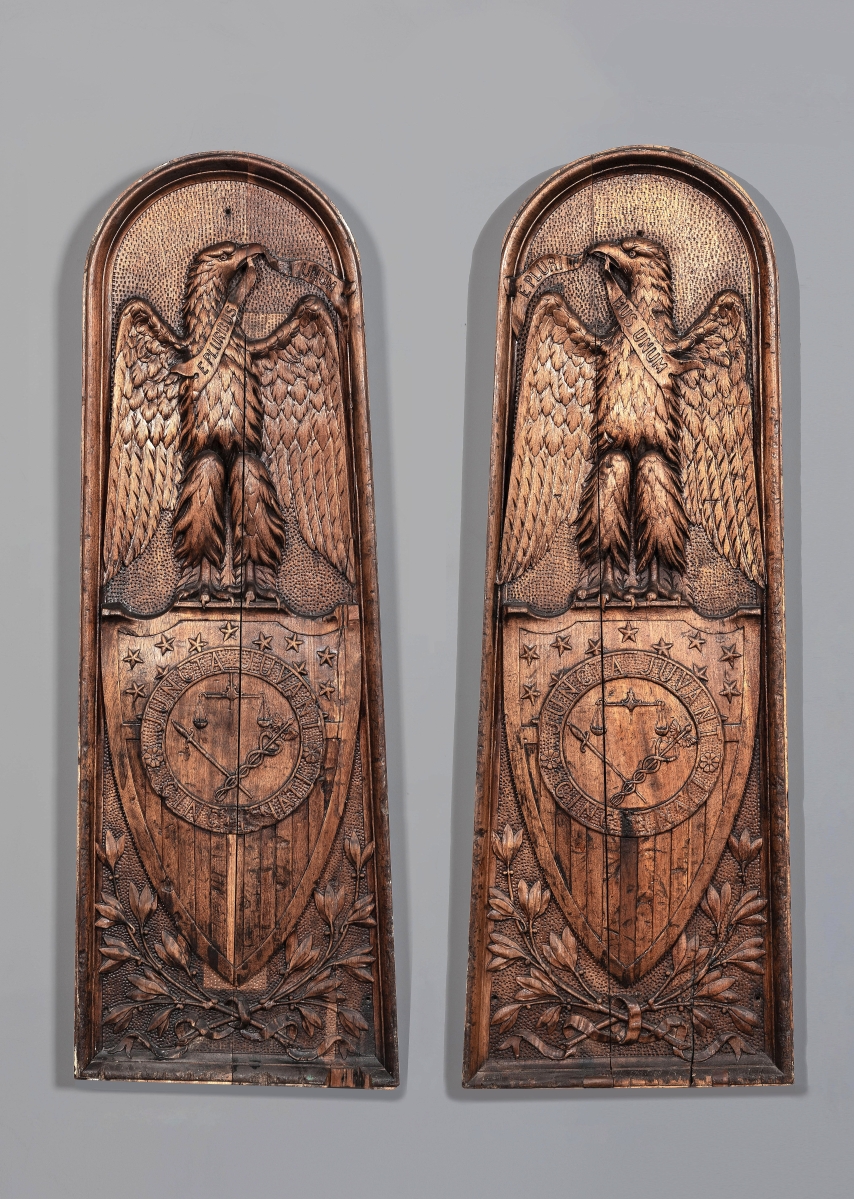
This rare pair of walnut gangway boards, each carved with an eagle, shield and the seal of Cincinnati, may have been from the naval cruiser USS Cincinnati and were from the collection of dealer Norm Flayderman. A private collector paid $17,500 for the pair ($10/15,000).
Also, of historical importance was a circa 1830 American or English school portrait of Ira Aldridge (1807-1867) in one of his most famed roles as Mungo in The Padlock, a farcical libretto composed and written in 1768 by Charles Dibdin and Isaac Bickerstaff. Aldridge was an American actor, playwright, theater manager and abolitionist born in Manhattan who moved to England in 1824 after he faced racist backlash to the African Grove Theatre’s all Black productions of Othello and Richard III. A 20-year career in Britain and, eventually Europe followed, though he never achieved success on the London stage. The painting, estimated at $30/50,000, sold to an institution for $21,250.
American furniture was led at $28,125 by a pair of Classical drapery carved mahogany side chairs that related to a set sold from the Patricia Sax collection, a Chippendale block-and-shell carved cherrywood chest of drawers, probably Connecticut, at $20,000, and, for $10,625, a set of six Chippendale volute-carved mahogany side chairs, Virginia or Maryland, circa 1800.
Prices quoted include the buyer’s premium as reported by the auction house.
Hindman’s next Americana sale will take place spring 2023. For information, 312-280-1212 or www.hindmanauctions.com.



















